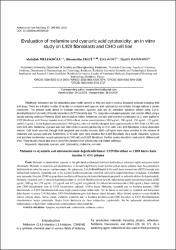| dc.contributor.author | Melekoglu, Abdullah | |
| dc.contributor.author | Ekici, Husamettin | |
| dc.contributor.author | Arat, Esra | |
| dc.contributor.author | Karahan, Siyami | |
| dc.date.accessioned | 2021-01-14T18:10:59Z | |
| dc.date.available | 2021-01-14T18:10:59Z | |
| dc.date.issued | 2020 | |
| dc.identifier.citation | Melekoğlu, A. , Ekici, H. , Arat, E. & Karahan, S. (2020). Evaluation of melamine and cyanuric acid cytotoxicity: an in vitro study on L929 fibroblasts and CHO cell line . Ankara Üniversitesi Veteriner Fakültesi Dergisi , 67 (4) , 399-406 . | en_US |
| dc.identifier.issn | 1300-0861 | |
| dc.identifier.issn | 1308-2817 | |
| dc.identifier.uri | https://doi.org/10.33988/auvfd.664059 | |
| dc.identifier.uri | https://hdl.handle.net/20.500.12587/12844 | |
| dc.description | Ekici, Husamettin/0000-0001-6403-737X | en_US |
| dc.description | WOS:000564411900010 | en_US |
| dc.description.abstract | Melamine and its metabolites pose health concern as they are used in various industrial products including feed and drugs. There are a limited number of studies on melamine and cyanuric acid cytotoxicity and cellular damage without a certain conclusion. The present study aimed to evaluate melamine, cyanuric acid and its combined cytotoxic effects using 3-(4.5-dimethylthiazol-2-yl) methyl thiazole tetrazolium (MTT) bromide test. The study also evaluated apoptotic and necrotic effect using a double staining method of Hoechst 33342 and propidium iodide. Melamine, cyanuric acid and their combination (1:1) were applied to L929 fibroblasts and Chinese hamster ovary (CHO) cells at various concentrations (1000 mu g/mL, 500 mu g/mL, 250 mu g/mL, 125 mu g/mL and 62.5 mu g/mL). At the highest concentration (1000 mu g/mL), the cell viability dropped down approximately to 50% both in CHO cells and L929 cells. Melamine, cyanuric acid and their mixture caused cytotoxicity in CHO cells and L929 fibroblasts in dose-dependent manner Cell death occurred through both apoptosis and mainly necrosis. Both cell types were more sensitive to the mixture of melamine and cyanuric acid and, furthermore, CHO cells were more sensitive than L929 fibroblasts. As a result, melamine, cyanuric acid and their combination caused cytotoxicity in CHO cells and L929 fibroblasts. Further studies should be conducted in different cell lines. These studies should also aim to reveal the mechanism of cytotoxicity and related pathways. | en_US |
| dc.language.iso | eng | en_US |
| dc.publisher | ANKARA UNIV PRESS | en_US |
| dc.relation.isversionof | 10.33988/auvfd.664059 | en_US |
| dc.rights | info:eu-repo/semantics/openAccess | en_US |
| dc.subject | Apoptosis | en_US |
| dc.subject | cyanuric acid | en_US |
| dc.subject | cytotoxicity | en_US |
| dc.subject | melamine | en_US |
| dc.subject | necrosis | en_US |
| dc.title | Evaluation of melamine and cyanuric acid cytotoxicity: an in vitro study on L929 fibroblasts and CHO cell line | en_US |
| dc.type | article | en_US |
| dc.contributor.department | KKÜ | en_US |
| dc.identifier.volume | 67 | en_US |
| dc.identifier.issue | 4 | en_US |
| dc.identifier.startpage | 399 | en_US |
| dc.identifier.endpage | 406 | en_US |
| dc.relation.journal | ANKARA UNIVERSITESI VETERINER FAKULTESI DERGISI | en_US |
| dc.relation.publicationcategory | Makale - Uluslararası Hakemli Dergi - Kurum Öğretim Elemanı | en_US |
















